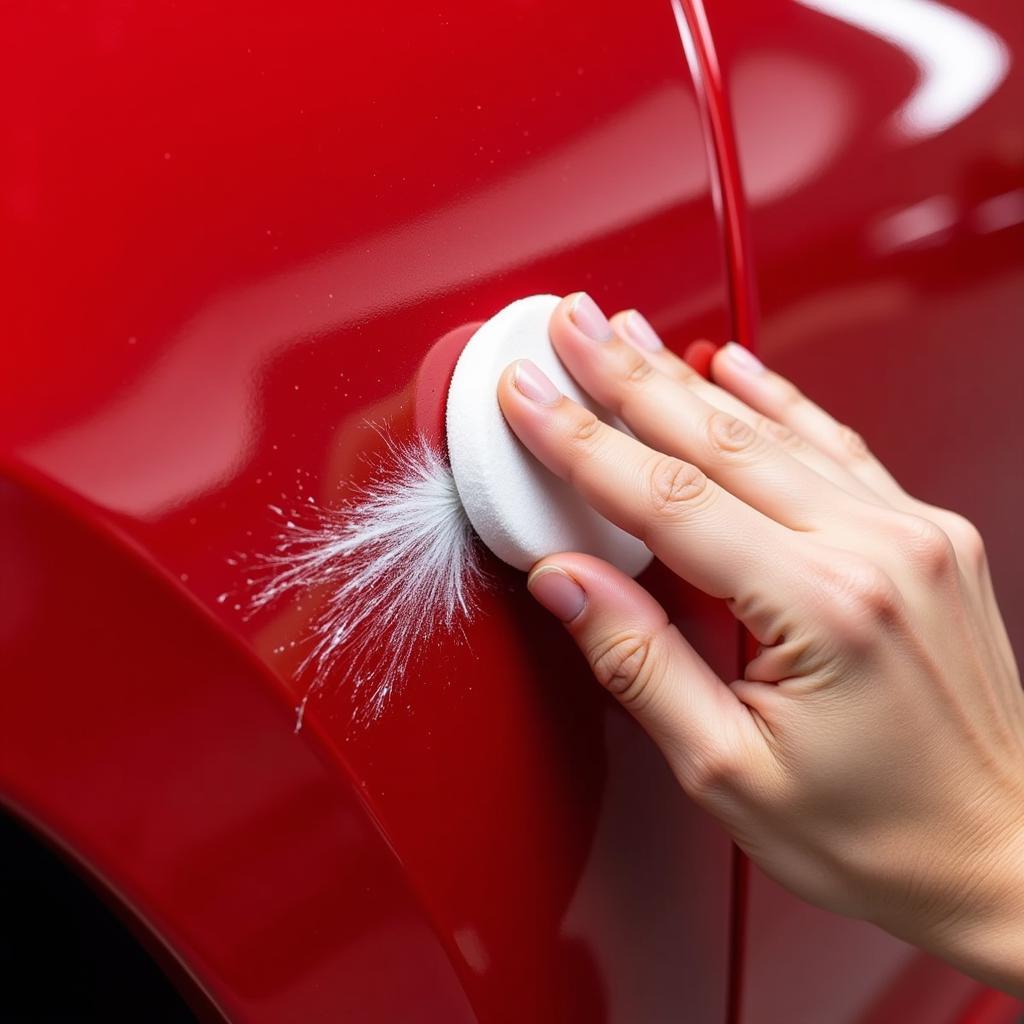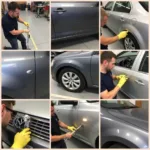Car body repair compound is a crucial tool for any DIY enthusiast or professional looking to restore their vehicle’s appearance. Whether you’re dealing with minor scratches, swirl marks, or deeper imperfections, understanding how to properly use this compound can save you time and money. This guide will delve into the intricacies of car body repair compound, from selecting the right type to achieving a flawless finish.
Choosing the Right Car Body Repair Compound
Selecting the correct car body repair compound depends on the severity of the damage and your experience level. Compounds are generally categorized by their abrasiveness, ranging from heavy-duty cutting compounds for deep scratches to fine polishing compounds for removing swirl marks and restoring shine. For minor scratches, a car body compound scratch repair guide can be very helpful.
Understanding Abrasiveness Levels
- Heavy-Duty Cutting Compounds: Ideal for deep scratches and significant paint imperfections. These compounds remove more material, requiring careful application to avoid further damage.
- Medium-Cut Compounds: A good balance between cutting power and finesse, suitable for moderate scratches and imperfections.
- Fine Polishing Compounds: Designed for removing swirl marks, light scratches, and restoring a high-gloss finish. These compounds are less abrasive and perfect for final polishing.
Choosing the wrong compound can exacerbate the problem, so it’s essential to assess the damage accurately. If you’re unsure, start with a less abrasive compound and progressively move to a more aggressive one if needed. You can also find expert advice on c h car body & scratch repairs.
Applying Car Body Repair Compound Like a Pro
Proper application is key to achieving a professional-looking finish. Here’s a step-by-step guide to help you through the process:
- Clean the Area: Thoroughly wash and dry the affected area to remove any dirt or debris.
- Apply the Compound: Apply a small amount of compound to a clean microfiber applicator pad.
- Work in Sections: Work the compound into the paint using overlapping circular motions. Apply moderate pressure, but avoid excessive force.
- Check Your Progress: Regularly wipe off the compound to assess your progress. If the scratch remains, continue the process.
- Final Polish: Once the scratch is removed, use a fine polishing compound to restore the shine and remove any swirl marks left by the cutting compound.
Common Car Body Repair Compound Mistakes to Avoid
- Using Too Much Compound: Applying too much compound can make it difficult to remove and may clog the applicator pad.
- Applying Too Much Pressure: Excessive pressure can damage the paint and create further imperfections.
- Using the Wrong Applicator Pad: Using a dirty or abrasive applicator pad can scratch the paint. Always use a clean, microfiber applicator pad.
- Not Checking Your Progress: Failing to check your progress can lead to over-polishing and potential paint damage.
“Remember, patience is key when working with car body repair compound,” says automotive expert, David Miller. “Taking your time and following the proper steps will ensure a flawless result.” For specific repairs, check out this guide on car bodywork scratch repairs at door m38.
Why Choose Car Body Repair Compound?
Car body repair compound offers several advantages over other methods of scratch repair:
- Cost-Effective: Compound is a relatively inexpensive solution compared to professional bodywork.
- DIY-Friendly: With the right tools and techniques, anyone can achieve professional-looking results.
- Versatile: Compound can be used on a variety of paint types and colors.
- Time-Saving: Compound can often repair scratches in a matter of minutes, saving you a trip to the body shop. You can even handle minor repairs yourself; see this guide on minor car body repairs.
Conclusion
Car body repair compound is an invaluable tool for maintaining your vehicle’s appearance. By understanding the different types of compounds, following proper application techniques, and avoiding common mistakes, you can achieve professional-looking results and restore your car’s paint to its former glory. Don’t forget to check out resources for specific repairs, like car body rust repair kit frosts.
FAQ
- Can I use car body repair compound on all types of paint?
- What type of applicator pad should I use with car body repair compound?
- How much compound should I apply at a time?
- How often can I use car body repair compound on my car?
- What should I do if I accidentally apply too much compound?
- Can I use car body repair compound on plastic trim?
- How do I remove swirl marks after using car body repair compound?
Need more help? Contact us via WhatsApp: +1(641)206-8880, or Email: [email protected]. Our customer support team is available 24/7.



